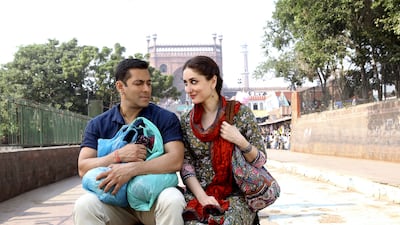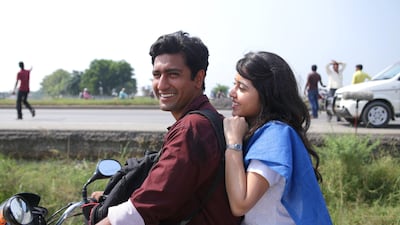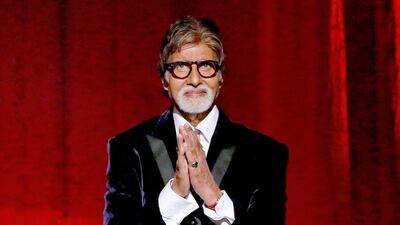Salman Khan's latest Bollywood film Bajrangi Bhaijaan has proved to be a huge hit, grossing more than 5 billion rupees (Dh288.1 million) since its release just three weeks ago.
It is not just cinemagoers in India that have propelled the film to already become the third highest-earning Indian movie of all time, however. Bajrangi Bhaijaan — which tells the story of a man played by Khan, aged 49 and one of Bollywood's biggest stars, who helps a mute Pakistani girl lost in India to return home — has become a major success internationally.
In the United States it stormed into the top 10 at the box office, and in the UAE it has grossed a reported $7.75m to become the biggest Hindi film ever in the country.
"Dubai is one of the biggest markets for Bollywood outside India," says Manju Ramanan, the editor of Filmfare Middle East, an Indian movie magazine. "We do go to the cinema at the weekend if it's a big film and a Salman Khan film will surely do well. A lot is to do with the fact that the expat population here is largely Indian and we're all very nostalgic about our homeland. Cinema is one of the biggest connects we have with our country."
Revenues from screenings of Indian films overseas grew to 8.6bn rupees last year from 8.3bn rupees the previous year, according to a report by KPMG and the Federation of Indian Chambers of Commerce and Industry (Ficci).
Bollywood is the largest film industry in the world. But just 10 to 25 per cent of gross collections for an Indian movie come from overseas theatricals, whereas for a Hollywood film, 60 per cent is collected from abroad, the report revealed. This means that there is huge potential for growth abroad, which Bollywood is increasingly focusing on. Extra revenues are all the more important as production costs continue to rise and profitability becomes ever more challenging. The Middle East, North America and the UK, which all have a large Indian diaspora, are the primary markets for Indian films, accounting for 70 per cent of overseas revenues.
The 2014 film Happy New Year, which starred Shah Rukh Khan and was set in Dubai, generated 31 per cent of its overseas revenues from the UAE, making it the largest foreign market for the film.
“Filmmakers and production houses seem to be looking at overseas theatrical beyond just an ancillary revenue stream,” according to the report. “Premieres at international locations and tie-ups with international agencies have all been exercises to increase traction in foreign countries and promote Indian films.”
The Middle East market grew by 25 to 30 per cent last year over the previous year and the US by up to 10 per cent, its figures showed.
“In the UK, Indian movies are struggling to connect with the third generation of Indian diaspora leading to a decline in collections from the region,” it said.
Experts believe that the UAE has scope for further expansion for Bollywood.
"It's absolutely growing," says Vikram Arora, the chief executive of Saffron Media Works in Dubai, a media house which publishes Filmfare Middle East and has a division which has worked on some below-the-line marketing efforts for Indian films. "You can see it in the effort made towards marketing Indian films today. You have so many premieres, so many roadshows. It's fantastic to see the film stars and the production houses recognising that this is a growing market."
He explains that it is not only high-budget blockbuster Indian movies that are doing well in the UAE. Budget and regional films are also proving to be increasingly popular. And as well as Indian audiences in the UAE, Bollywood films are also attracting large numbers of Pakistani and Arab cinemagoers in the country, he says.
A relatively low-budget film, Masaan, was released in the UAE this year and was received very well, says Ms Ramanan.
As the industry’s popularity increases, revenues and costs are soaring.
Ghajini, a 2008 Bollywood thriller inspired by Christopher Nolan's Memento, broke a record when it became the first movie to earn more than 1bn rupees at the Indian box office. In 2012, nine Bollywood movies entered what has became known as the illustrious 100 crore (1bn rupee) club. Now, as Indian cinema continues to rise to new heights, the biggest hits are generating well over that figure.
The biggest-earning movie of all time in India is last year's comedy PK, starring Aamir Khan, which grossed 7.35bn rupees worldwide.
Production costs are continuing to rise in India, with actors demanding ever higher fees and more expensive sets.
A list of the highest paid actors globally in 2015 compiled by Forbes, released last week, revealed that India's Amitabh Bachchan, at US$33.5m, Salman Khan with $33.5m and Akshay Kumar, $32.5m, had all made it into the top 10, ahead of Hollywood stars including Johnny Depp and Leonardo DiCaprio.
"Earlier you would shoot in a studio and it would be pretty shabby the way the sets were," says Mr Arora. "Today these are live locations. A movie has been completely on a cruise ship, like Dil Dhadakne Do, one of the big blockbusters of this year. Obviously the spend is bigger."
The report by KPMG and Ficci highlights that a 1bn rupees is "not enough" these days. It cites the example of last year's Singham Returns. The action film was a massive success and generated more than 1.3bn rupees at the box office last year but it delivered much lower returns than the first film, Singham, which was released in 2011.
“The sequel was produced with a total budget of 1.15bn rupees,” according to the report. “On the contrary, the first edition was produced with a budget of 0.2bn rupees and collected more than 1bn rupees in its year of release.”
Sanjay Chakraborty, a marketing communication adviser, based in Ahmedabad in Gujarat, says that there are noticeable efforts by the industry to push into markets abroad, with the International Indian Film Academy Awards held in foreign countries each year.
“India is known for movies,” he says. “It’s an advantage if Indian movies become popular abroad too and in turn the industry grows.”
There are a number of other countries that Bollywood can tap beyond the traditional overseas markets.
“The industry is experiencing mushrooming demand from new markets such as Japan, China, South Korea and Peru, where films are distributed with subtitles in the native language of those markets,” according to the KPMG and Ficci report.
It added that certain Indian films with rich content, including PK, Haider, and 2 States, had managed to do well among non-Hindi speaking audiences but concluded that "overall though, Indian cinema is still reliant on diaspora audiences with limited crossover appeal".
It is not just the film industry that can capitalise on the trend of the rising popularity of Indian films abroad.
Mr Arora says that companies in the UAE could do much more to tap the popularity of Bollywood in the country, by tying up with Bollywood stars as brand ambassadors, for example.
“More commercial opportunities could be created,” he says. “There’s huge potential for growth. You have to recognise that Indian cinema is running a lot of volume business here.”
business@thenational.ae
Follow The National's Business section on Twitter





